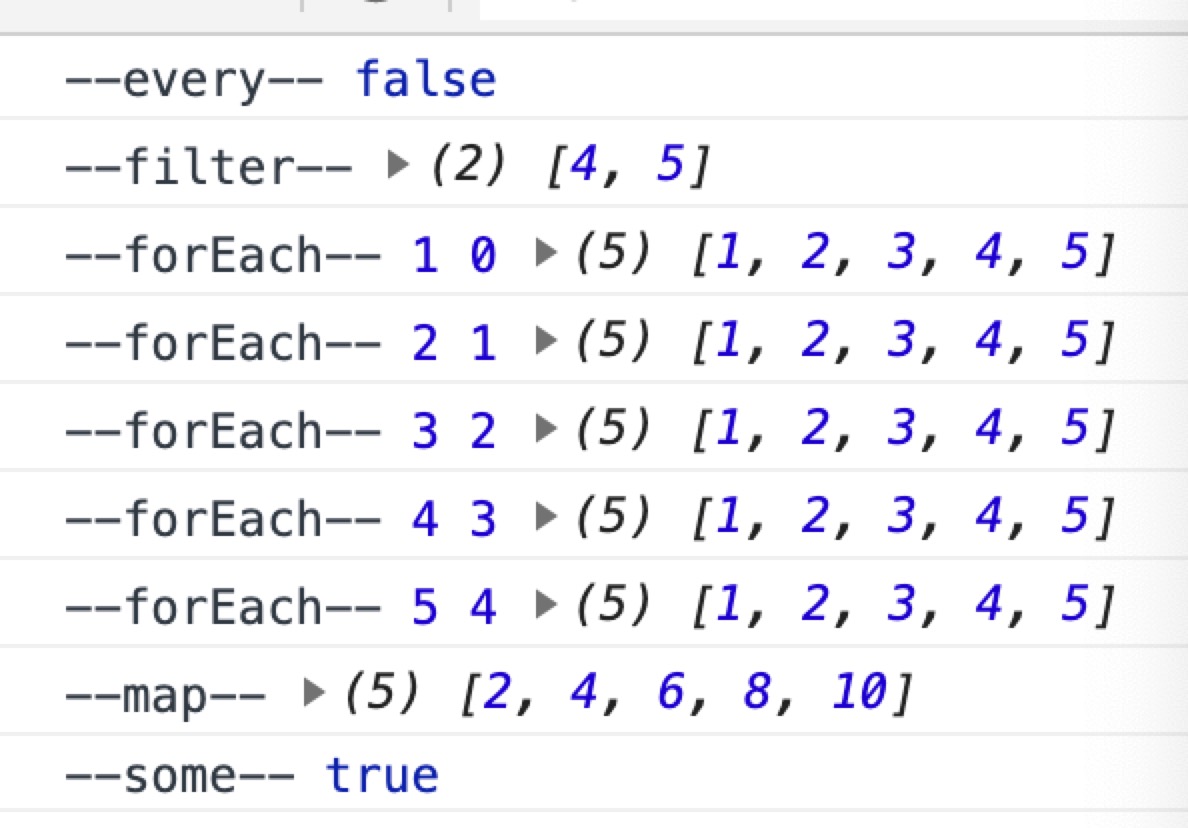js数组篇2----ECMASCript5为数组定义了5个迭代方法和归并方法reduce()和reduceRght()
数组定义了5个迭代方法和归并方法
上一篇总结数组的基础用法,感兴趣可以可以看之前总结:
今天主要总结一下ECMASCript5为数组定义了5个迭代方法和归并方法reduce()和reduceRght()
一、ECMASCript5为数组定义了5个迭代方法
1、every():对数组中的每一项运行给定的函数,如果该函数对每一项都返回true,则返回true。
2、filter():对数组中的每一项运行给定函数,返回该函数会返回true的项目组成的数组。
3、forEach():对数组中的每一项运行给定的函数。这个方法没有返回值。
4、map():对数组中的每一项给定函数,返回每次调用返回结果的数组
5、some():对数组中的每一项运行给定函数,如果该函数对任意项返回true,则返回true
let numbers = [1,2,3,4,5]; let everyRes = numbers.every(function(item, index, array){ return (item>2); }); console.log('--every--', everyRes);// false let filterRes = numbers.filter(function(item, index, array){ return (item>3); }); console.log('--filter--', filterRes);// [4, 5] numbers.forEach(function(item,index,array){ console.log('--forEach--', item, index, array);// }); let mapRes = numbers.map(function(item,index,array){ return item*2; }); console.log('--map--', mapRes);//[2, 4, 6, 8, 10] let mapRes = numbers.map(function(item,index,array){ return item>3; }); console.log('--map--', mapRes);//[false, false, false, true, true] var someRes = numbers.some(function(item,index,array){ return (item>2); }); console.log('--some--', someRes);//true

二、归并方法
ECMASCript5 新增两个归并数组的方法reduce()和reduceRght()
两个数组都会迭代数组所有项,然后构建一个最终返回值。
其中,reduce() 方法从数组的第一项开始,逐个遍历到最后 reduceRght()方法从数组的第后一项开始,向前遍历到第一项
语法:
arr.reduce(callback(accumulator, currentValue[, index[, array]])[, initialValue])
callback
执行数组中每个值 (如果没有提供 initialValue则第一个值除外)的函数,包含四个参数:
accumulator
累计器累计回调的返回值; 它是上一次调用回调时返回的累积值,或initialValue(见于下方)。
currentValue
数组中正在处理的元素。
index 可选
数组中正在处理的当前元素的索引。 如果提供了initialValue,则起始索引号为0,否则从索引1起始。
array可选
调用reduce()的数组
initialValue可选
作为第一次调用 callback函数时的第一个参数的值。 如果没有提供初始值,则将使用数组中的第一个元素。 在没有初始值的空数组上调用 reduce 将报错。
2.1、数组里所有值的和
let sum = [0, 1, 2, 3].reduce(function (accumulator, currentValue) { return accumulator + currentValue; }, 0); // sum 6 //箭头函数的形式: let total = [ 0, 1, 2, 3 ].reduce( ( acc, cur ) => acc + cur, 0 );
2.2、累加对象数组里的值
let initialValue = 0; let sum = [{x: 1}, {x:2}, {x:3}].reduce(function (accumulator, currentValue) { return accumulator + currentValue.x; },initialValue) console.log(sum) // logs 6 //你也可以写成箭头函数的形式: let initialValue = 0; let sum = [{x: 1}, {x:2}, {x:3}].reduce( (accumulator, currentValue) => accumulator + currentValue.x ,initialValue ); console.log(sum) // logs 6
2.3、将二维数组转化为一维
let flattened = [[0, 1], [2, 3], [4, 5]].reduce( function(a, b) { return a.concat(b); }, [] ); // flattened is [0, 1, 2, 3, 4, 5] //你也可以写成箭头函数的形式: let flattened = [[0, 1], [2, 3], [4, 5]].reduce( ( acc, cur ) => acc.concat(cur), [] );
2.4、计算数组中每个元素出现的次数
//计算数组中每个元素出现的次数 let names = ['Alice', 'Bob', 'Tiff', 'Bruce', 'Alice']; let countedNames = names.reduce(function (allNames, name) { if (name in allNames) { allNames[name]++; } else { allNames[name] = 1; } return allNames; }, {}); //countedNames is: // { 'Alice': 2, 'Bob': 1, 'Tiff': 1, 'Bruce': 1 }
2.5、按属性对object分类
let people = [ { name: 'Alice', age: 21 }, { name: 'Max', age: 20 }, { name: 'Jane', age: 20 } ]; function groupBy(objectArray, property) { return objectArray.reduce(function (acc, obj) { console.log(acc, obj) var key = obj[property]; if (!acc[key]) { acc[key] = []; } acc[key].push(obj); return acc; }, {}); } var groupedPeople = groupBy(people, 'age'); ------->result:: groupedPeople is: { 20: [ { name: 'Max', age: 20 }, { name: 'Jane', age: 20 } ], 21: [{ name: 'Alice', age: 21 }] }



 浙公网安备 33010602011771号
浙公网安备 33010602011771号